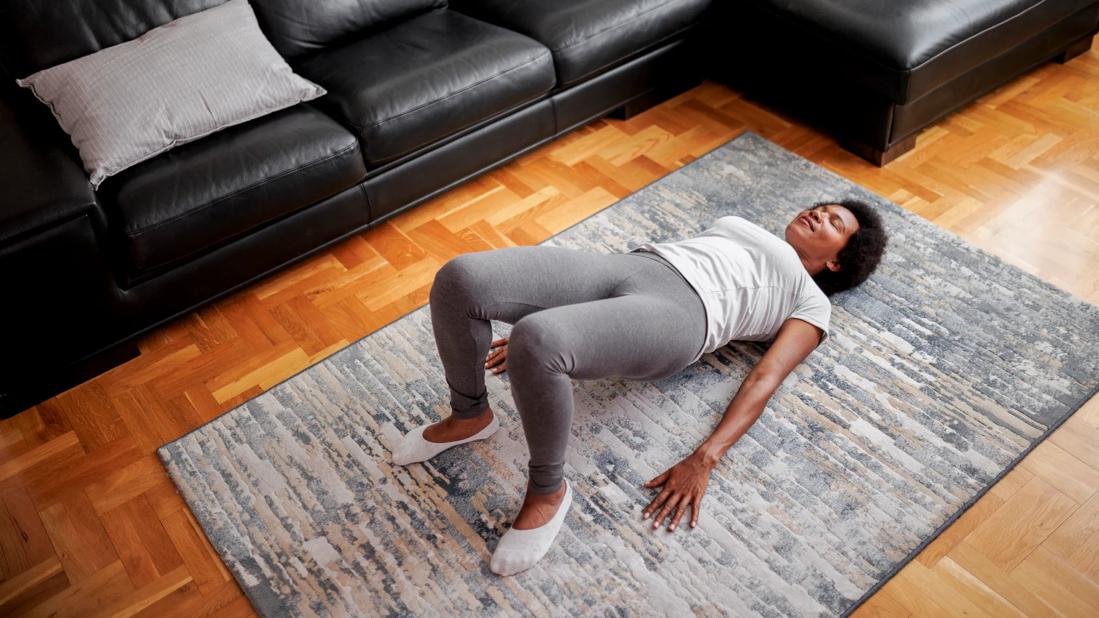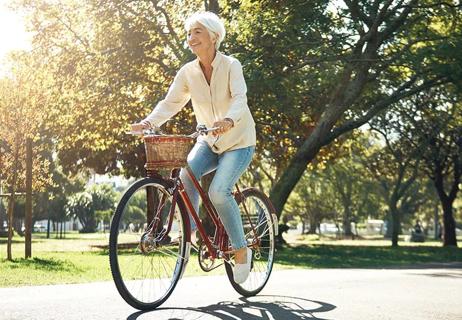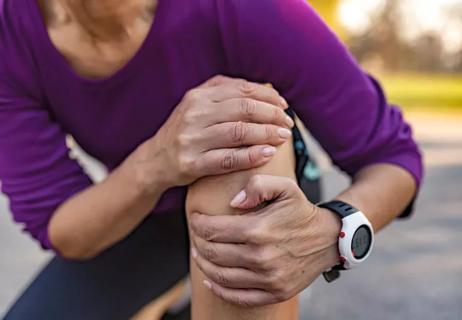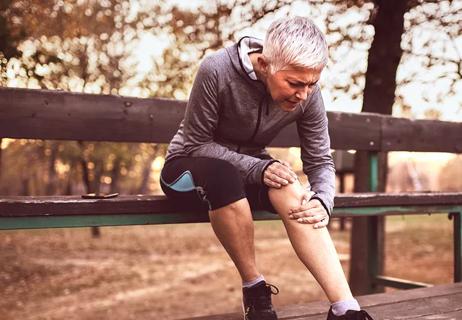Standing on your feet all day. Climbing stairs. Squatting down to pick up your child or move a heavy object. Anything that involves straightening, bending or stretching your knees and legs can cause pain and other complications if you have knee arthritis.
Advertisement
Cleveland Clinic is a non-profit academic medical center. Advertising on our site helps support our mission. We do not endorse non-Cleveland Clinic products or services. Policy
“For people who come to see us with a diagnosis of knee arthritis, their biggest challenge tends to be pain, and that pain limits their activity when they’re on their feet,” says physical therapist Tim Bungo, PT, SCS. “Sometimes, it affects their ability to tolerate exercise, standing for any length of time and walking on stairs.”
Fortunately, there are exercises and stretches you can do to help strengthen your quads, thighs and gluteal muscles — all of which support your ability to extend or straighten your knees so you can do everyday things like stand up from a seated position.
Exercises for knee arthritis
“Anytime you have a joint that’s arthritic or a joint that’s injured in any way, it can have a potential negative effect on other areas of your body,” explains Bungo. “Sometimes, you end up compensating for that injury without even realizing it, and it might affect the opposite side because you tend to use that side to favor the arthritic side.”
To avoid further injury and reduce the amount of pain associated with knee arthritis, you’ll want to exercise carefully and in a way that doesn’t aggravate the condition.
“If you’ve been diagnosed with knee arthritis, you want to avoid impact activities like running, jumping and high-impact aerobics, along with lunging and deep squats,” warns Bungo. “These could aggravate your symptoms and make you feel worse.”
Building a routine around the following 20 exercises could be more helpful.
1. Straight leg raise
- Lie flat on your back on the ground or on a yoga mat, with your hands at your side and your legs stretched out in front of you.
- Tighten your quads and lift one leg about a foot off the floor, keeping your knee locked. Hold for three seconds. Then, lower your leg back down.
- Repeat this process for two sets of 15 reps for both legs.
2. Quad set
- Begin by lying flat on your back, with one knee bent and resting on a towel roll and your other leg straight.
- Gently squeeze your thigh muscles, pushing the back of your bent knee down into the towel.
- Make sure to keep your back flat against the floor during this exercise.
- Repeat this process for two sets of 15 reps for both legs.
3. Lying quad stretch
- Lie flat on your back near the edge of a bed.
- Bend your right leg so your right foot is flat on the bed.
- Hang your left leg over the edge of the bed, keeping your leg relaxed and your thigh resting against the bed. Hold this position for 10 to 15 seconds.
- Repeat this process with the opposite leg, for two to three times each leg.
4. Side-lying leg raise
- Lie on your side with your hips, knees and feet stacked in a straight line.
- Rest your top arm in front of you, using your hand to maintain your balance.
- Keeping your top leg straight, lift it up to hip height and hold it there for a count of two to three seconds. Then, slowly lower your leg.
- Repeat this process for two sets of 15 reps for both legs.
5. Bridging
- Begin by lying flat on your back.
- Tighten your lower abdominal muscles (your core), squeeze your buttocks and raise your butt off the floor or bed, keeping your back straight. Hold this position for five seconds.
- Repeat this process for two sets of 15 reps.
6. Step-ups
- Start in a standing, upright position at the bottom of a set of stairs or in front of a yoga block.
- While holding onto a stable surface for support (like a handrail), bend your knee, lift one foot and step forward onto the step or block with that foot. Then, step up onto the block with your other foot.
- Step back down to the ground in the reverse order.
- Repeat this process for one to two sets of 10 reps.
- You can also switch positions and do this laterally (sideways). If you do, maintain your balance during the exercise and keep your hips level, with your pelvis parallel to the ground.
7. Sit-to-stand
- Start by sitting upright in a chair, with your back straight and head facing forward.
- Cross your arms on your chest and lean your torso forward without tilting your head.
- Press into your feet to stand up straight, then slowly sit back down and repeat.
- Make sure you maintain your balance and distribute your weight evenly into both legs. Do not lock your legs while standing.
- Repeat this process for three sets of five reps.
- If you need to, you can hold onto the back of another chair or small countertop while standing for extra support.
8. Mini squats at a countertop
- Begin in a standing, upright position with your feet shoulder-width apart and your hands resting on a countertop.
- Slowly bend your knees to sink into a mini squat position.
- Hold this squatting position for a couple of seconds, then press into your feet to return to a standing, upright position.
- Make sure to keep your heels on the ground and use the counter to help you balance as needed. Don’t let your knees bend forward past your toes or collapse inward.
- Repeat this process for three sets of five reps.
9. Tandem balance
- Start in a standing, upright position with your arms resting at your sides.
- Place one foot directly in front of the other so you’re standing heel-to-toe.
- Maintain your balance in this position and try not to move your arms away from your body, keeping your back straight.
- Hold this position for as long as you can, working toward achieving two to three reps of 30-second holds, rotating between your left and right foot as the leg in front.
10. Single-leg balance
- Start in a standing, upright position with your feet together and arms resting at your sides.
- Lift one foot off the floor, balancing on your other leg. Try to maintain your balance while holding this position.
- Try not to move your arms away from your body or let your weight shift from side to side. If you need extra support, extend both of your arms out to your side or hold onto a rail or countertop with one arm.
- Work toward achieving two to three reps of 15 seconds on each foot.
11. Calf stretch with towel, strap or resistance band
- Begin by sitting on the floor, bed or bench with one foot stretched out on the surface in front of you.
- Bend your other knee so your foot is perpendicular to your side and your thigh is pressed flat.
- Secure a strap, towel or resistance band around your bent foot and slowly pull your foot toward you until you feel the stretch in your calf.
- Keep your knee straight during this exercise.
- Repeat the process for three to five reps of 10- to 15-second holds, alternating legs between holds.
12. Seated hamstring stretch
- Begin by sitting upright on the edge of a solid, elevated surface (like a bench) or bed, with one leg resting straight on the surface and your other foot flat on the floor.
- Gently lean forward, hinging at your hips, until you feel a stretch on the back of your leg and hold that position.
- While holding this position, keep your knees straight and toes pointing up toward the ceiling. Don’t round your back as you bend forward.
- Repeat this process for three to five reps of 10- to 15-second holds, alternating legs between holds.
13-20. Other exercises
If you prefer exercising at a gym, there are several machine exercises you may find helpful, including:
- Double leg press
- Single leg press
- Calf raises
- Seated hamstring curls
Alternatively, low-impact exercises like swimming and water aerobics, brisk walking, cycling or yoga can also help strengthen your legs and hips and improve your flexibility over time.
“With water exercises, the buoyancy of the water helps to unload your joints, but you can still get some good resistance from a strength standpoint, working against the resistance of the water,” Bungo explains.
When to see a healthcare provider
Exercise can take some time to get used to.
“These exercises might be a little bit painful, but when you’re done with your workout, you shouldn’t feel worse as a result of going through the exercises,” notes Bungo. “You should feel like you did something. You might feel fatigued or a little bit tired, but you shouldn’t have a significant increase in pain.”
If you do have an increase in pain or feel your condition has worsened and it doesn’t get better with rest or recovery, make an appointment with a physical therapist or primary care provider. They can take a look at what’s causing your pain and help you find relief.
“Often, you might experience more pain if you’re doing too many reps, too many sets or one of these exercises is just not right for you at the time,” shares Bungo. “We can certainly help with all of those things.”











